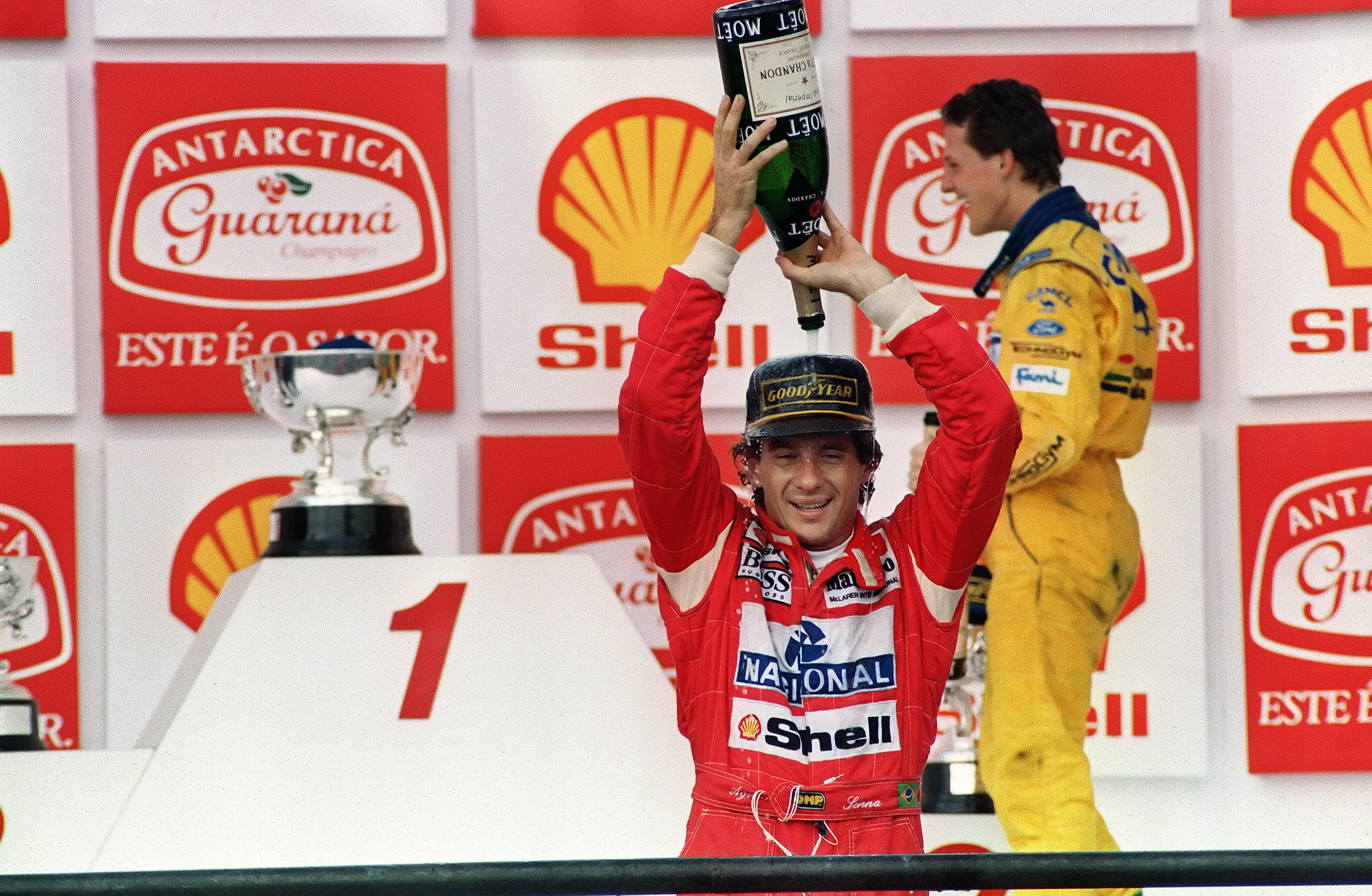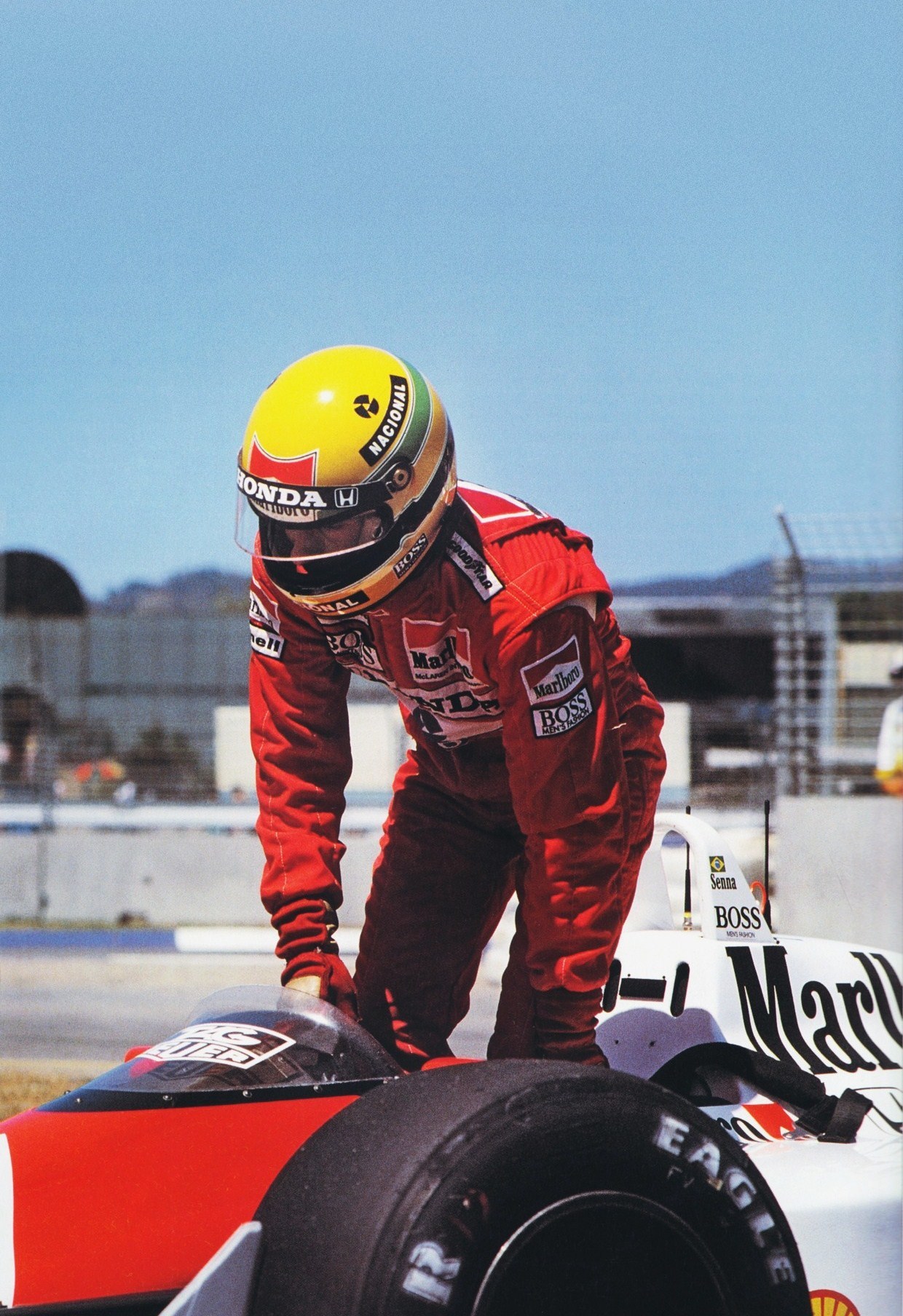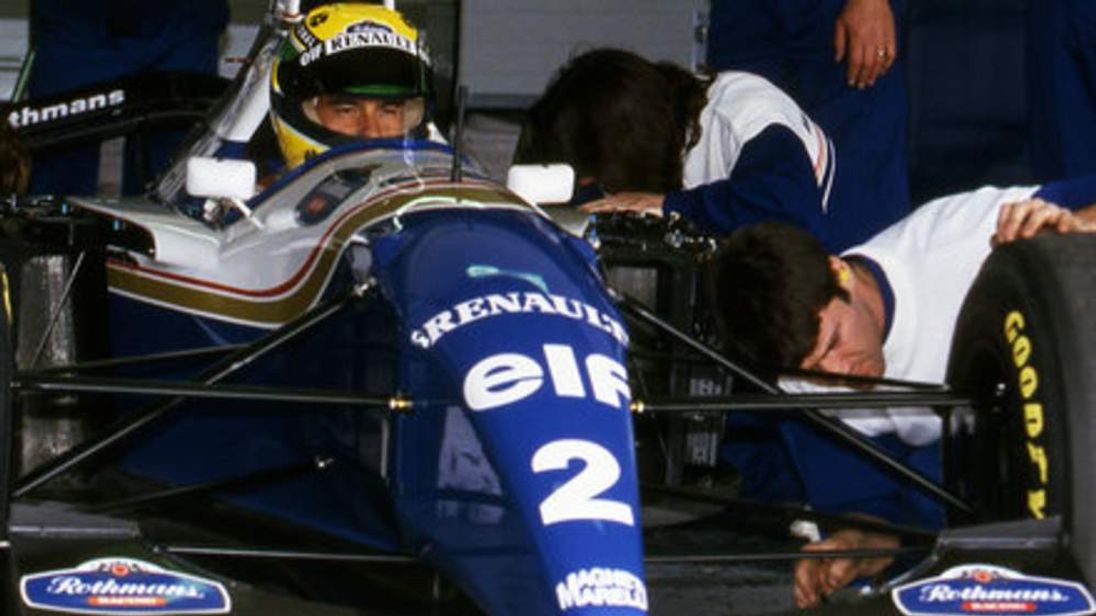Ut racing was Senna's life, and he took to the track the next day holding the pole position (his 65th, by far the all-time record, again until Schumacher) once again. After the false hope of a quick head twitch, Senna lay motionless in the car, finally being pulled from the wreckage, given first aid and taken away in a helicopter. He died hours later from massive head injuries — caused when a suspension arm from the disintegrating Williams punctured his helmet. Michael Schumacher observed later that "For me, dying on a race track was something related to the past, to the times I didn't know a lot about, but clearly not to 'our' times. Gone are the days of straw bales and, for the most part, concrete walls on the edge of tracks. The efficacy of trackside barriers has been greatly increased, and they are able to absorb most of the energy of a car crashing at high speed.
Among the other trackside measures is the introduction of the safety car to slow the field while the scene of an accident is cleared or a stricken car removed. Pit lane speed limits have also been introduced and progressively lowered to prevent racing in an area full of team crews and trackside personnel. From the first days of motor racing, drivers have lived close to the edge.
Thanks to marked improvements in safety standards, the number seriously injured and killed competing in the sport has significantly reduced. The last death of a driver in an F1 car was Ayrton Senna in 1994, but in the early years the toll was alarming. Here is a list of all those who have died racing in Formula One, not including officials and spectators. Between 1950 and 1961 the Indianapolis 500 was considered part of the Formula One championship, even though few European drivers made the trip over to America to compete. Although the drivers are highly skilled and have lots of practice, it is still amazing that there are not more fatal accidents in each of the three motorsports of F1, IndyCar and NASCAR.
It can seem like there is a crash in each of these events in every single race, and so it is really an achievement for the industry that there are rarely any fatalities. This will go down in history as the most talked about F1 fatality in its history. The legendary Brazilian died when his car crashed into a concrete wall, causing head injuries. His death was the second that weekend, after Roland Ratzenberg had a fatal crash in qualify.
These two deaths prompted calls for major safety overhaul, which led to no death recorded for two decades, before Bianchi's crash. On 1 May 1994, Brazilian Formula One driver Ayrton Senna was killed after his car crashed into a concrete barrier while he was leading the 1994 San Marino Grand Prix at the Autodromo Enzo e Dino Ferrari in Italy. The previous day, Austrian driver Roland Ratzenberger had died when his car crashed during qualification for the race. His and Senna's crashes were the worst of several that took place that weekend and were the first fatal collisions to occur during a Formula One race meeting in 12 years . This became a turning point in the safety of Formula One, prompting the implementation of new safety measures in both Formula One and the circuit, as well as the Grand Prix Drivers' Association to be reestablished. The Supreme Court of Cassation of Italy ruled that mechanical failure was the cause of the crash.
Although many years after Formula One's deadliest period in the 1970s, Brazilian Ayrton Senna's death marked the unthinkable. The Brazilian tragically lost his life during the San Marino Grand Prix in Imola after crashing his Williams car into a concrete wall at 145 mph. Till, everyone expected that the combination of Senna and Williams would make 1994 a cake walk to the World Championship. Williams and Senna, visibly moved and sitting by Barrichello's bedside with tears in his eyes when Barrichello regained consciousness, withdrew from the final qualifying session.
Senna telephoned his girlfriend in Lisbon to say he did not want to race on Sunday. Ayrton Senna is wildly regarded as one of the greatest racing drivers of all time. Senna has 3 world titles and 41 race wins to his name, but it is the events at the San Marino Grand Prix that the younger generation best know Senna for.
This tragic weekend saw Senna suffer a fatal accident, and questions from that crash still remain today. Below I take a look at what exactly happened on that fateful day, and the mystery of the events on 1 May 1994. Two fatal crashes on the same weekend at the same race track decimated the spirits of Formula 1. The loss of one of the greatest sportsmen in racing history led FIA to take stringent steps to ensure high-speed impacts do not lead to fatalities. Among other things, Formula 1 car design was overhauled to ensure the parts that disintegrate during a crash won't injure drivers in the future.
Although the deaths of these racing legends were tragic events, they helped the sport to develop many of the modern safety devices and regulations that are used in the sport today. As a result of this, Formula One celebrated the 20th fatality-free season in 2014, up until Bianchi's accident in Japan. The 2000's remains the only decade to date in which no driver was killed. But as Peterson lay on the tarmac, track officials hampered attempts to get an ambulance to him and it was a quarter of an hour before medical aid arrived. There was more concern for Vittorio Brambilla, who had head injuries, and he was the first to be treated, and fortunately he made a full recovery. At the hospital surgeons, with Peterson's agreement, operated that night to stabilise ten fractures in his legs.
However, during the night bone marrow went into his bloodstream through the fractures leading to him suffering full renal failure. Ratzenberger was unable to control the vehicle and crashed into a concrete wall at the high-speed Villeneuve corner, sustaining a fatal skull fracture and multiple injuries. This heart-wrenching crash happened just a day before Senna's fatal accident on Imola weekend .
After the impact with a concrete barrier, the car bounced off and rested in the middle of that section of the track. Senna saw the replays of the collision and rushed into the pitlane to get inside a course car. When he arrived, with Ratzenberger taken into an ambulance, Senna inspected the damaged Simtek.
He then attended the circuit's Medical Centre where he learnt from neurosurgeon Sid Watkins that Ratzenberger had died from injuries sustained in the accident. When the two left the centre together, Watkins told Senna that he did not have to race ever again and suggested that he withdraw from the race and go fishing with him. Before we get to the Sunday race, lets take a moment to remember Roland Ratzenberger. The Austrian was also tragically killed on this weekend, during qualifying on Saturday, as his car hit a wall he suffered a number of injures including a ruptured aorta, and passed away upon arrival at the hospital. The official cause of death being stated as a basilar skull fracture.
In the early days of the championship, death was a regular occurrence. Twenty-four hours later, Senna died when his car failed to negotiate a sharp corner and slammed into a concrete wall at around 135mph. As officials examined the wreckage they found a furled Austrian flag which, had he won, Senna would have raise in honour of Ratzenberger.
Donohue lost control of his March during a practice session and careered into fencing. A marshal was killed by flying debris but it was thought Donohue was alright. However, he suffered from a worsening headache and the next day went to hospital where he lapsed into a coma and died from a brain haemorrhage. It was believed his head had struck a wooden fence post during the crash. During the safety car period, Érik Comas brought his Larrousse-Ford to the pit lane to correct a vibration issue caused by contact under a yellow flag on the first lap.
Shortly after the helicopter landed on the racing surface, Comas left the pit area and attempted to rejoin the now red flagged Grand Prix due to a miscommunication with his crew. When he spotted Comas approaching the accident scene, John Watson — covering the events as an analyst for EuroSport — said it was the "most ridiculous thing I've ever seen at any time in my life". Safety standards have improved since the first World Championship Grand Prix at Silverstone in 1950, where there was no medical back-up or safety measures in case of an accident. It was not until the 1960s these were first introduced, as helmets and overalls became mandatory and the FIA assumed responsibility for safety at the circuits. Steps were taken to improve the safety of the Formula One car in the 1970s; the cockpit opening was enlarged allowing the driver to escape more quickly in the event of an accident and outside mirrors became mandatory.
The 1980s saw further improvement in the structure of the Formula One car, with the monocoque being made out of carbon fibre instead of aluminium, increasing protection upon impact. Grooved tyres were introduced in 1998 instead of racing slick tyres to reduce cornering speed. Safety measures continued to be introduced into the 21st century, with a number of circuits having their configuration changed to improve driver safety. Formula One is the highest class of open-wheeled auto racing defined by the Fédération Internationale de l'Automobile , motorsport's world governing body. The "formula" in the name refers to a set of rules to which all participants and vehicles must conform.
The F1 World Championship season consists of a series of races, known as Grands Prix, held usually on purpose-built circuits, and in a few cases on closed city streets. The results of each race are combined to determine two annual Championships, one for drivers and one for constructors. A piece of the suspension assembly penetrated his helmet visor, and he died of fatal skull fractures. Senna's death was the second to have taken place in two days, as Austrian Roland Ratzenberger too had lost his life, after suffering a similar crash during race qualifying.
During the team meeting before the race, Senna had raised concerns about the race going forward. Formula 1 is filled with historical events which many fans, drivers and team members look back on with a smile. 27 years ago, Ayrton Senna crashed during the 1994 San Marino Grand Prix in Imola and died from the multiple injuries he sustained. The three-time world champion Ayrton Senna collided with the Tamburello wall on lap seven of the race at Imola, coming off the racing line on the corner at 190mph before striking the unprotected barrier. The drivers had raised concerns over safety before the race after the wing of Ratzenberger's car collided with a wall at the corner after Tamburello.
Three times world champion Ayrton Senna was one of the greatest F1 racers of all time, but on the fateful day of the Imola weekend race, he left us forever. The tragedy happened during lap 7 of the 1994 San Marino Grand Prix when approaching the Tamburello corner; Senna slightly overshot the corner and collided with the bare concrete wall at 131 MPH . You will notice that the vast majority of all deaths in Formula One occurred within the first 30 years of the motorsport's existence.
How Many F1 Drivers Have Died Since Senna This is largely due to a lack of safety regulations and protocols that are now mandatory during all World Championship events. For example, cockpit openings have been enlarged so that drivers can escape easier in the event of an emergency. Ayrton Senna's death led to the introduction of measures such as bodywork aerodynamic limitations, speed limits for pit lanes, and circuit modifications.
Unser, who had been involved in the 15-car pile-up a year earlier, died when he lost control during a practice session, his car hitting a wall and then somersaulting down the track before exploding. The accident led to fire-resistant driving suits becoming mandatory. Lewis-Evans' Vanwall engine seized and sent him crashing into barriers at high speed, his car bursting into flames. He was airlifted back to England on team boss Tony Vandervell's private plane but died in hospital of burns six days later. Despite winning the inaugural constructors' championship, Vandervell was so distraught he withdrew from racing, as, for a time, did Lewis-Evans' manager Bernie Ecclestone. Fifty-year-old Miller was the oldest driver on the track when he lost control of his Novi Special and piled into a concrete wall at over 100mph during practice.
Shortly after the finish Carl Scarborough collapsed and died from heat exhaustion. The car swerved into the infield, before shooting straight back across the track into the outer wall. Cortner's head hit the steering wheel and he died later that day of "massive head injuries". Another American, Jerry Unser, had died just two days earlier on the same track. Hamilton was on course to claim a record-breaking eighth world title at the season-ending race in December before Latifi crashed into a wall with five laps left, which led to the deployment of the safety car. That gave Verstappen time to pit for fresher tyres, enabling him to overtake Hamilton when the race was restarted.
From 1954 and 1994, a total of 24 deaths were recorded alongside numerous other life-changing injuries in the history of F1. And, on 17th July 2015, Jules Bianchi, unfortunately became F1's 25th fatality. The 25-year-old Marussia driver succumbed to the brain injuries sustained in a crash during the Japanese Grand Prix in October 2014. He was in a coma since the accident, in which he collided at high speed with a mobile crane which was being used to pick up another crashed car. NASCAR drivers are notorious for driving much closer to each other than F1 and IndyCar drivers. This is partly because they can afford to bump off each other more than the fragile open wheel cars, but this also makes them very prone to accidents from small – but high speed – collisions.
There are also more cars on the track, which makes the likelihood of others being involved in crashes much higher. The 25-year-old French driver died from head injuries nine months after the accident at a wet Japanese Grand Prix, the first to pass away since the death of Senna 20 years previous. Bianchi's car slid off track and collided with a crane picking up the car of Adrian Sutil, who had crashed in the same position a lap earlier.
Formula 1 is the pinnacle of motorsports and many consumer automotive technologies trickle down from the high-octane racing that has gripped generations for years. The high drama of street circuits, fierce duels between rival drivers, and even teammate battles have kept automotive fans on the edges of their seats every season. While the glitz and glamour of the sport are overwhelming, one cannot deny the dangers involved in racing at break-neck speeds. A minor accident caused the safety car to be deployed and after safety laps, the race resumed from the 6th lap. Fate awaited Senna in the 7th lap as his car went straight into the concrete wall and struck at the speed of over 200 km/h.
This was go down as the most tragic death in F1 history, considering it could have been avoided. At Monza, a mass collision of cars ensued which caused severe injuries to a few drivers, including Peterson. He was pulled out of his blazing car by three fellow drivers, with severe leg injuries. The ambulance took longer than expected to arrive, and then he was then rushed to the hospital. The operation on his leg went horribly wrong though, and he past away the next morning. Belgian driver Charles de Tornaco also died after crashing his practice run at the Modena Grand Prix on 18 September 1953.
He rolled his Ferrari Tipo 500 and died of head and neck injuries on the way to the hospital. The 26-year-old's death can be considered a consequence of a lack of medical staff and facilities, considering that there wasn't even an ambulance present, and he died in a private car. Fifty-two drivers have died in accidents at FIA World Championship events or other events while driving Formula 1 cars, with the vast majority occurring in the 50s, 60s, and 70s. Since the FIA adopted various safety protocols, only one driver has died at an FIA World Championship event since 1994.
A veteran of 100 Formula One starts, Siffert was killed in a non-championship race at Brands Hatch when the suspension on his BRM snapped causing him to crash. He was unable to get out of the car as it caught fire and died of smoke inhalation. A subsequent investigation revealed none of the track-side extinguishers had been working and the incident led to mandatory in-car extinguishers as well as piped air into the driver's helmet. The only man to win the drivers' championship posthumously, Rindt died during final practice at Monza when his car crashed into perimeter fencing and disintegrated. He had only just started wearing a seat belt and it is believed that as he slid down inside the cockpit it cut his throat. The crash was in exactly the same place that von Trips had died nine years earlier.
One race later and Ferrari suffered a second blow when Collins, who was lying third in the drivers' championship, lost control while battling for the lead and his car careered into fencing. Collins was thrown out of the cockpit and hit a lone tree, dying later that day from a fractured skull. On lap 7, the second lap at racing speed, Senna's car left the racing line at Tamburello, ran in a straight line off the track and struck an unprotected concrete barrier.
Telemetry data recovered from the wreckage shows he entered the corner at 309 km/h and then braked hard, downshifting twice to slow down before impacting the wall at 211 km/h . The car hit the wall at a shallow angle, tearing off the right front wheel and nose cone before spinning to a halt. "Some of those Formula 1 drivers who can be listed as the death of a Grand Prix driver actually were driving other forms of motor sports…Indeed Jim Clark was killed in a Formula 2 accident in 1968." The Brazilian legend, and arguably the greatest F1 driver in history, lost his life at the 1994 San Marino Grand Prix when, on lap seven, his Williams car smashed into a concrete wall on the Imola track.



























